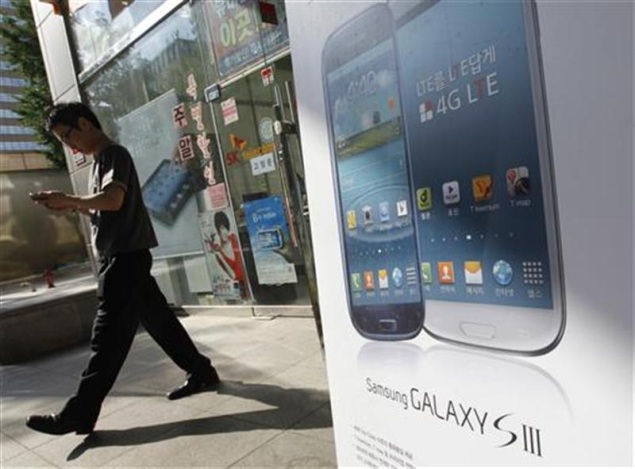- Home
- Mobiles
- Mobiles News
- After verdict, assessing the Samsung strategy in South Korea
After verdict, assessing the Samsung strategy in South Korea

"The ruling makes us reconsider the brand value of Samsung because it depicts Samsung as a copycat," said James Song, who monitors Samsung for KDB Daewoo Securities in Seoul. "But a copycat or not, what Samsung has done with its smartphones was a brilliant move."
"Look what has happened to companies like Nokia, Motorola and BlackBerry, which didn't do as Samsung did," Mr. Song added, referring to competitors whose failures to adapt quickly to the smartphone boom driven by iPhones have drastically reduced their market shares. "Samsung may lack in innovation, but right now, no one can beat Samsung in playing catch-up."
For months, the South Korean media have watched avidly as Samsung, the world's largest technology company by sales, clashes with Apple, the world's No. 1 company by market value, over patent lawsuits in various countries.
Calling Samsung South Korea's biggest, most profitable and most globally recognized brand barely explains the intense and often mixed emotions the name evokes among South Koreans. In Samsung, they see the crown jewel of their country's transformation from a war-torn agrarian society into a global technology powerhouse.
Once an assembler of clunky transistor radios, Samsung is now the world's top seller of smartphones and high-resolution television sets, as well as memory chips and flat-panel displays that allow those devices and others to store and display data.
Japanese companies have beaten rivals to the market with hardware innovations like flat-panel televisions and high-end mobile phones. Samsung waited for the others to test the market, and when it determined the time was right, it joined the fray to cash in.
Samsung's strategy was to build something similar to another company's product but to make it better, faster and at lower cost. When it pounced, it flooded the market with a wide range of models that were constantly updated with incremental improvements at a speed its rivals found hard to match a strategy best illustrated by its smartphone business. Heavy investments have not been a problem; it once secured low-cost loans from a government-controlled banking sector friendly to big businesses and now draws on its own coffers, which are sloshing with cash.
Several years ago, Sony, Sharp and Panasonic were the first companies to market flat-panel televisions. But they obsessed over craftsmanship or held onto the old cathode-ray tube while dithering over the rival flat-panel technologies of plasma screen and liquid crystal displays, or LCDs.
Samsung placed billion-dollar bets on mass production of television-size LCDs. Its economies of scale helped it drive down prices to create, then clinch, the LCD television market.
Five years ago, Sony was the first company to make what is widely seen as the next-generation television. It featured the OLED display organic light-emitting diode which is thinner, more vivid and more energy-efficient. Sony was never able to mass-produce or market it; it was too expensive. Samsung and its domestic rival, LG Electronics, tiptoed in, building mass-production capabilities by first making smaller OLEDs for high-end smartphones. Then last week they pounced, announcing the marketing of 55-inch OLED televisions.
"Koreans do things quicker than almost anyone," said Anthony Michell, author of "Samsung Electronics and the Struggle for Leadership of the Electronics Industry." "This allows them to change models, go from design to production faster than anyone at the present time. Korean companies continually set themselves challenges, like the challenge to overtake Sony in terms of brand value in the past."
Copyright 2012 The New York Times News Service
For the latest tech news and reviews, follow Gadgets 360 on X, Facebook, WhatsApp, Threads and Google News. For the latest videos on gadgets and tech, subscribe to our YouTube channel. If you want to know everything about top influencers, follow our in-house Who'sThat360 on Instagram and YouTube.
Related Stories
- Galaxy S24 Series
- MWC 2024
- Apple Vision Pro
- Oneplus 12
- iPhone 14
- Apple iPhone 15
- OnePlus Nord CE 3 Lite 5G
- iPhone 13
- Xiaomi 14 Pro
- Oppo Find N3
- Tecno Spark Go (2023)
- Realme V30
- Best Phones Under 25000
- Samsung Galaxy S24 Series
- Cryptocurrency
- iQoo 12
- Samsung Galaxy S24 Ultra
- Giottus
- Samsung Galaxy Z Flip 5
- Apple 'Scary Fast'
- Housefull 5
- GoPro Hero 12 Black Review
- Invincible Season 2
- JioGlass
- HD Ready TV
- Laptop Under 50000
- Smartwatch Under 10000
- Latest Mobile Phones
- Compare Phones
- Vivo V30e
- Itel Super Guru 4G
- Huawei Pura 70 Pro+
- Huawei Pura 70 Ultra
- Tecno Camon 30 Premier 5G
- Motorola Edge 50 Fusion
- Oppo A1i
- Oppo A1s
- Asus ZenBook Duo 2024 (UX8406)
- Dell Inspiron 14 Plus
- Realme Pad 2 Wi-Fi
- Redmi Pad Pro
- Cult Shock X
- Fire-Boltt Oracle
- Samsung Samsung Neo QLED 8K Smart TV QN800D
- Samsung Neo QLED 4K Smart TV (QN90D)
- Sony PlayStation 5 Slim Digital Edition
- Sony PlayStation 5 Slim
- Hitachi 2 Ton 5 Star Inverter Split AC (RAS.G522PCBISF)
- Haier 1.5 Ton 5 Star Triple Inverter Split AC (HSU18K-PYSS5BN-INV)

















